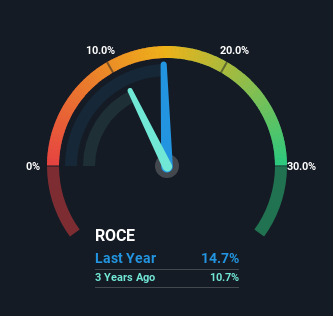Returns On Capital At Kadant (NYSE:KAI) Have Stalled
To find a multi-bagger stock, what are the underlying trends we should look for in a business? Ideally, a business will show two trends; firstly a growing return on capital employed (ROCE) and secondly, an increasing amount of capital employed. If you see this, it typically means it's a company with a great business model and plenty of profitable reinvestment opportunities. That's why when we briefly looked at Kadant's (NYSE:KAI) ROCE trend, we were pretty happy with what we saw.
Understanding Return On Capital Employed (ROCE)
For those that aren't sure what ROCE is, it measures the amount of pre-tax profits a company can generate from the capital employed in its business. The formula for this calculation on Kadant is:
Return on Capital Employed = Earnings Before Interest and Tax (EBIT) ÷ (Total Assets - Current Liabilities)
0.15 = US$166m ÷ (US$1.2b - US$42m) (Based on the trailing twelve months to December 2023).
Thus, Kadant has an ROCE of 15%. In absolute terms, that's a satisfactory return, but compared to the Machinery industry average of 12% it's much better.
Check out our latest analysis for Kadant
Above you can see how the current ROCE for Kadant compares to its prior returns on capital, but there's only so much you can tell from the past. If you're interested, you can view the analysts predictions in our free analyst report for Kadant .
What Can We Tell From Kadant's ROCE Trend?
The trend of ROCE doesn't stand out much, but returns on a whole are decent. The company has employed 89% more capital in the last five years, and the returns on that capital have remained stable at 15%. Since 15% is a moderate ROCE though, it's good to see a business can continue to reinvest at these decent rates of return. Over long periods of time, returns like these might not be too exciting, but with consistency they can pay off in terms of share price returns.
One more thing to note, even though ROCE has remained relatively flat over the last five years, the reduction in current liabilities to 3.6% of total assets, is good to see from a business owner's perspective. Effectively suppliers now fund less of the business, which can lower some elements of risk.
In Conclusion...
To sum it up, Kadant has simply been reinvesting capital steadily, at those decent rates of return. And long term investors would be thrilled with the 285% return they've received over the last five years. So while investors seem to be recognizing these promising trends, we still believe the stock deserves further research.
If you're still interested in Kadant it's worth checking out our FREE intrinsic value approximation for KAI to see if it's trading at an attractive price in other respects.
If you want to search for solid companies with great earnings, check out this free list of companies with good balance sheets and impressive returns on equity.
Have feedback on this article? Concerned about the content? Get in touch with us directly. Alternatively, email editorial-team (at) simplywallst.com.
This article by Simply Wall St is general in nature. We provide commentary based on historical data and analyst forecasts only using an unbiased methodology and our articles are not intended to be financial advice. It does not constitute a recommendation to buy or sell any stock, and does not take account of your objectives, or your financial situation. We aim to bring you long-term focused analysis driven by fundamental data. Note that our analysis may not factor in the latest price-sensitive company announcements or qualitative material. Simply Wall St has no position in any stocks mentioned.

